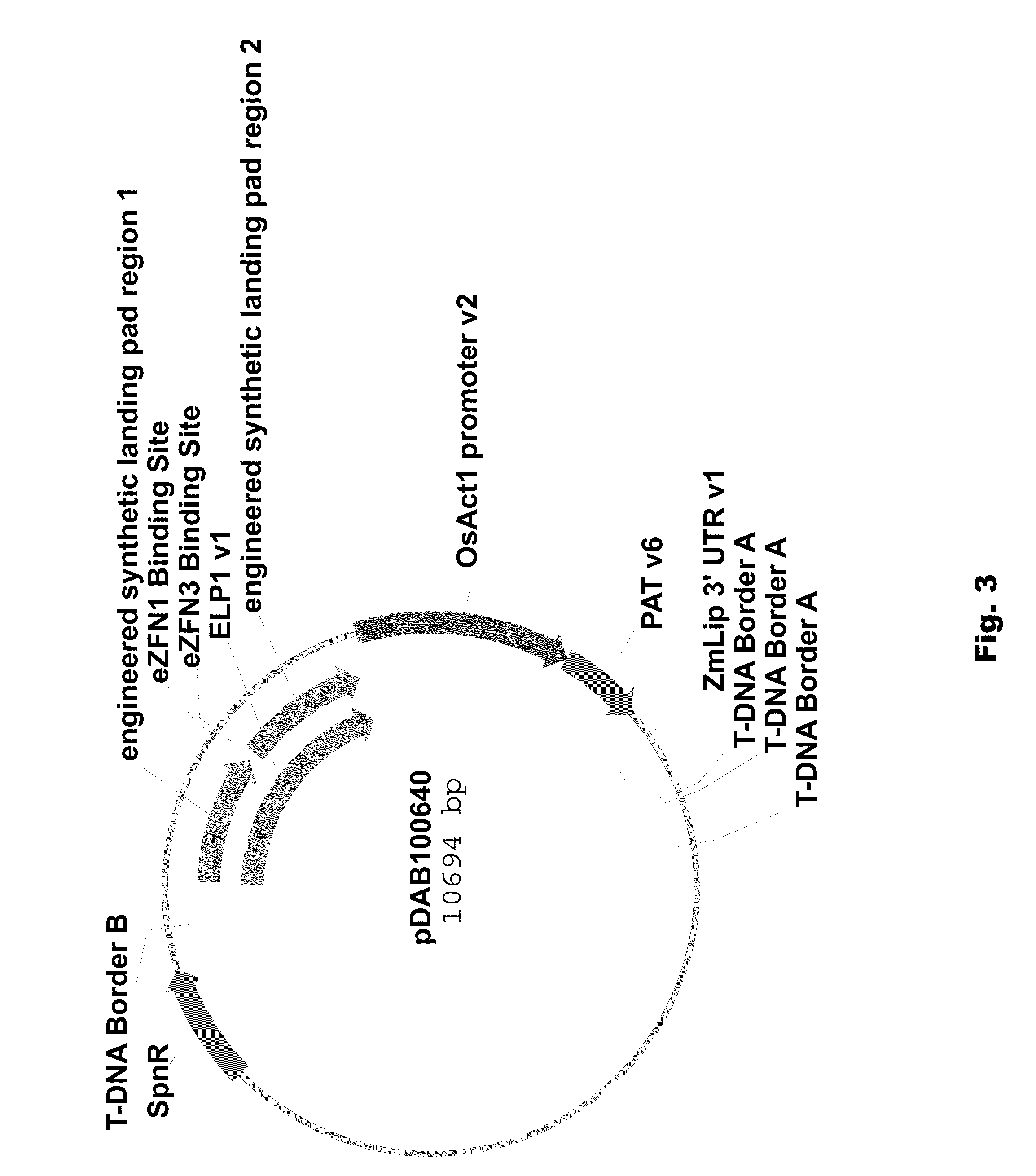Engineered landing pads for gene targeting in plants
- Summary
- Abstract
- Description
- Claims
- Application Information
AI Technical Summary
Benefits of technology
Problems solved by technology
Method used
Image
Examples
example 1
Vector Construction
[0089]Two different ELPs were synthesized that consisted of a 1 kbp 5′ region of homology (“engineered landing pad region 1” (SEQ ID NO: 11) in pDAB100610 / pDAB100640 and “engineered synthetic homology region 3” (SEQ ID NO: 12) in pDAB100611 / pDAB100641) and a 1 kbp 3′ region of homology (“engineered landing pad region 2” (SEQ ID NO: 13) in pDAB100610 and “engineered synthetic homology region 4” (SEQ ID NO: 14) in pDAB100611 / pDAB100641). These regions of homology were separated by two different EXZACT Zinc Finger Nuclease (eZFN) binding sites.
[0090]The two ELPs used for pDAB100610 and pDAB100611, designated ELP1 (SEQ ID NO: 15) and ELP2 (SEQ ID NO: 16), respectively, were transferred using the GATEWAY® LR clonase reaction (Invitrogen, Carlsbad, Calif.) into pDAB100704, a destination superbinary vector which is derived from pSB11 (WO94 / 00977 and WO95 / 06722). pDAB100704 contains the ZmUbil promoter (promoter, 5′ untranslated region (UTR) and intron derived from the Ze...
example 2
Whiskers-Mediated DNA Delivery
[0095]Embryogenic Hi-II cell cultures of maize were produced as described in U.S. Pat. No. 7,179,902, and were used as the source of living plant cells in which targeted integration was exemplified.
[0096]Fragments containing the AAD-1 plant selectable marker cassette and the ELP1 and ELP2, respectively, from pDAB100610 and pDAB100611 and fragments containing the PAT plant selectable marker cassette and the ELP1 and ELP2, respectively, from pDAB100640 and pDAB100641 were used to generate transgenic events. Transgenic events were isolated and characterized. These events were then targeted using homology-directed homologous recombination, wherein a nucleic acid molecule of interest can be integrated within the engineered landing pad.
[0097]12 mL of packed cell volume (PCV) from a previously cryo-preserved cell line plus 28 mL of conditioned medium was subcultured into 80 mL of GN6 liquid medium (N6 medium (Chu et al., (1975) Sci Sin. 18:659-668), 2.0 mg / L 2...
example 3
Identification and Isolation of Putative Transgenic Events
[0100]One week post-DNA delivery, filter papers were transferred to 60×20 mm plates of GN6 (1H) selection medium (N6 medium, 2.0 mg / L 2,4-D, 30 g / L sucrose, 100 mg / L myo-inositol, 2.5 g / L Gelrite, pH 5.8) containing the appropriate selective agent. These selection plates were incubated at 28° C. for one week in the dark. Following 1 week of selection in the dark, the tissue was embedded onto fresh media by scraping ½ the cells from each plate into a tube containing 3.0 mL of GN6 agarose medium held at 37-38° C. (N6 medium, 2.0 mg / L 2,4-D, 30 g / L sucrose, 100 mg / L myo-inositol, 7 g / L SEAPLAQUE® agarose, pH 5.8, autoclaved for 10 minutes at 121° C.).
[0101]The agarose / tissue mixture was broken up with a spatula and, subsequently, 3 mL of agarose / tissue mixture was evenly poured onto the surface of a 100×15 mm petri dish containing GN6 (1 H) medium. This process was repeated for both halves of each plate. Once all the tissue was ...
PUM
| Property | Measurement | Unit |
|---|---|---|
| Digital information | aaaaa | aaaaa |
Abstract
Description
Claims
Application Information
 Login to View More
Login to View More - R&D
- Intellectual Property
- Life Sciences
- Materials
- Tech Scout
- Unparalleled Data Quality
- Higher Quality Content
- 60% Fewer Hallucinations
Browse by: Latest US Patents, China's latest patents, Technical Efficacy Thesaurus, Application Domain, Technology Topic, Popular Technical Reports.
© 2025 PatSnap. All rights reserved.Legal|Privacy policy|Modern Slavery Act Transparency Statement|Sitemap|About US| Contact US: help@patsnap.com



